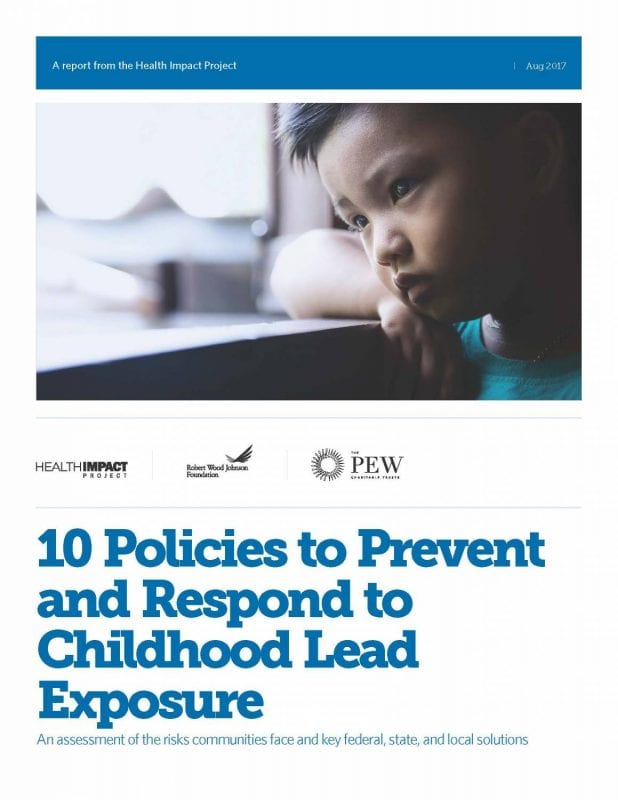10 Policies to Prevent and Respond to Childhood Lead Exposure
The Health Impact Project, a collaboration of the Robert Wood Johnson Foundation and The Pew Charitable Trusts, released a seminal report, 10 Policies to Prevent and Respond to Childhood Lead Exposure, in August 2017. The Health Impact Project is a national initiative designed to promote the use of health impact assessments (HIAs) as a decision-making tool for policy makers.
The Health Impact Project convened a team of researchers to assess the implications of childhood lead exposure and perform a cost-benefit analysis of various policies to prevent and respond to the problem. The study team conducted a literature review, case studies, interviews, national listening sessions, focus groups, and quantitative analyses using models developed by Altarum Institute and the Brookings Institution, Child Trends, and Urban Institute. The team included staff from Altarum, Child Trends, Urban Institute, Trust for America’s Health, the National Center for Healthy Housing, and the Health Impact Project.
The study team analyzed existing policies for their impacts on public health and health equity: the concept that every person should have the same opportunity to be healthy. The effort was guided by a diverse group of advisors and experts from fields including environmental and public health, child development, economics, housing, healthcare, environmental and social justice, and drinking water engineering. In addition, input from stakeholders, including families whose children have suffered the toxic effects of lead, provided valuable insights.
How the Information Is Presented
Where economic benefits are estimated, they are referred to as “future benefits”—meaning they are discounted at a rate of 3% per year to account for changes in the value of money over time. The cost-benefit analyses are based on the lifelong impacts of interventions for a single cohort of U.S. children, those who will be born in 2018. Where appropriate, the analysis includes benefits that would accrue for additional children born into the same households within 10 years. In some cases, costs were unavailable so a cost-benefit ratio is not provided.
These economic calculations do not include emotional distress or other potentially large costs to families, such as time away from work.
Here are the 10 policies to prevent and respond to childhood lead poisoning:
- Reduce lead in drinking water in homes built before 1986 and other places children frequent.
- Remove lead paint hazards from low-income housing built before 1960 and other places children spend time.
- Increase enforcement of the federal Renovation, Repair, and Painting (RRP) rule.
- Reduce lead in food and consumer products.
- Reduce air lead emissions.
- Clean up contaminated soil.
- Improve blood lead testing among children at high risk of exposure and find and remediate the sources of their exposure.
- Ensure access to developmental and neuropsychological assessments and appropriate high-quality programs for children with elevated blood lead levels.
- Improve public access to local data.
- Fill gaps in research to better target state and local prevention and response efforts.
Case Studies: Lead Poisoning Prevention and Response
NCHH and the Trust for America’s Health worked with the Pew Charitable Trusts, the Robert Wood Johnson Foundation, and local advocates and officials to publish 14 case studies about lead poisoning and prevention initiatives.
Key Findings from the Health Impact Project
Here are some of the findings discussed in the report:
- Removing leaded drinking water service lines from the homes of children born in 2018 would protect more than 350,000 children and yield $2.7 billion in future benefits, or about $1.33 per dollar invested. Of those benefits, about $2.2 billion in higher lifetime earnings, better health, and other gains would accrue to 272,000 children born in the 2018 cohort, and $550 million would come from protecting the roughly 80,000 other children born into those homes over the next 10 years. The total includes $480 million for the federal government and $250 million for states and municipalities from health and education savings and increased tax revenue associated with higher earnings among the cohort. Replacing these lead pipes would cost an estimated $2 billion.
- Eradicating lead paint hazards from older homes of children from low-income families would provide $3.5 billion in future benefits, or approximately $1.39 per dollar invested, and protect more than 311,000 children. About $2.8 billion of those benefits would accrue to roughly 244,000 of the four million children in the 2018 cohort. The other $670 million in benefits would accrue from protecting approximately 67,000 additional children born into those homes over the next 10 years. The total benefits include $630 million in federal and $320 million in state and local health and education savings and increased revenue. Controlling lead paint hazards would cost $2.5 billion for the 2018 cohort.
- Ensuring that contractors comply with the Environmental Protection Agency’s rule that requires lead-safe renovation, repair, and painting practices would protect about 211,000 children born in 2018 and provide future benefits of $4.5 billion, or about $3.10 per dollar spent. This includes $990 million in federal and $500 million in state and local health and education savings and increased revenue. The effort would cost about $1.4 billion.
- Eliminating lead from airplane fuel would protect more than 226,000 children born in 2018 who live near airports, generate $262 million in future benefits, and remove roughly 450 tons of lead from the environment every year.
- Providing targeted evidence-based academic and behavioral interventions to the roughly 1.8 million children with a history of lead exposure could increase their lifetime family incomes and likelihood of graduating from high school and college and decrease their potential for teen parenthood and criminal conviction. No studies have specifically assessed the effectiveness of such programs for lead-exposed children. However, research shows that for children at similar developmental risk from trauma, poverty, and other adverse experiences, certain high-quality interventions can increase the likelihood of earning a high school diploma and a four-year college degree and reduce the chance of becoming teen parents. The estimated benefits presume comparable impacts on lead-exposed children.
Preventing childhood lead exposure requires significant policy and regulatory action, coordination across levels of government, and public and private investments.
Prevention of childhood lead poisoning can generate substantial economic and public health gains in the short and long terms. According to the Health Impact Project findings, the maximum potential future benefits of preventing all lead exposure for the 2018 birth cohort, such that those children’s blood lead levels could be kept from rising above zero, could reach $84 billion, not including the costs to achieve such total prevention. This figure includes nearly $18.5 billion for the federal government and $9.6 billion for states in the form of increased revenue and savings to the healthcare, education, and criminal justice systems.
Resources
- 10 Policies to Prevent and Respond to Childhood Lead Exposure [pdf; Health Impact Project, 2017]
- NSHHC Webinar – 10 Policies to Prevent and Respond to Childhood Lead Exposure [mp4; YouTube, 2017]

